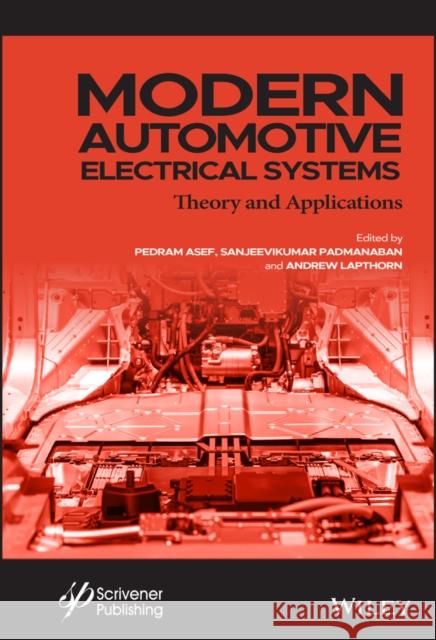Modern Automotive Electrical Systems » książka



Modern Automotive Electrical Systems
ISBN-13: 9781119801047 / Angielski / Twarda / 2022 / 350 str.
Modern Automotive Electrical Systems
ISBN-13: 9781119801047 / Angielski / Twarda / 2022 / 350 str.
(netto: 769,60 VAT: 5%)
Najniższa cena z 30 dni: 784,77 zł
ok. 22 dni roboczych.
Darmowa dostawa!
1 General Introduction and Classification of Electrical Powertrains 1Johannes J.H. Paulides, Laurentiu Encica, Sebastiaan van der Molen and Bruno Ricardo Marques1.1 Introduction 11.2 Worldwide Background for Change 61.3 Influence of Electric Vehicles on Climate Change 121.4 Mobility Class Based on Experience in the Netherlands (Based on EU Model) 131.5 Type-Approval Procedure 181.6 Torque-Speed Characteristic of the Powertrain for Mobility Vehicles 231.7 Methods of Field Weakening Without a Clear Definition 311.8 Consideration and Literature Concerning "Electronic" Field Weakening: What Does it Mean? 331.9 Summary of Electronic Field Weakening Definitions 351.10 Critical Study of Field Weakening Definitions 361.11 Motor Limits 401.12 Concluding Remarks 49References 512 Comparative Analyses of the Response of Core Temperature of a Lithium Ion Battery under Various Drive Cycles 55Sumukh Surya and Vineeth Patil2.1 Introduction 562.2 Thermal Modeling 622.3 Methodology 632.4 Simulation Results 652.5 Conclusions 71References 713 Classification and Assessment of Energy Storage Systems for Electrified Vehicle Applications: Modelling, Challenges, and Recent Developments 75Seyed Ehsan Ahmadi and Sina Delpasand3.1 Introduction 763.2 Backgrounds 793.2.1 EV Classifications 793.2.2 EV Charging/Discharging Strategies 803.2.2.1 Uncontrolled Charge and Discharge Strategies 803.2.2.2 Controlled Charge and Discharge Strategies 803.2.2.3 Wireless Charging of EV 813.2.3 Classification of ESSs in EVs 833.3 Modeling of ESSs Applied in EVs 843.3.1 Mechanical Energy Storages 843.3.1.1 Flywheel Energy Storages 843.3.2 Electrochemical Energy Storages 843.3.2.1 Flow Batteries 853.3.2.2 Secondary Batteries 853.3.3 Chemical Storage Systems 923.3.4 Electrical Energy Storage Systems 943.3.4.1 Ultracapacitors 943.3.4.2 Superconducting Magnetic 953.3.5 Thermal Storage Systems 953.3.6 Hybrid Storage Systems 963.3.7 Modeling Electrical Behavior 963.3.8 Modeling Thermal Behavior 1003.3.9 SOC Calculation 1023.4 Characteristics of ESSs 1043.5 Application of ESSs in EVs 1053.6 Methodologies of Calculating the SOC 1063.6.1 Current-Based SOC Calculation Approach 1073.6.2 Voltage-Based SOC Calculation Approach 1083.6.3 Extended Kalman-Filter-Based SOC Calculation Approach 1103.6.4 SOC Calculation Approach Based on the Transient Response Characteristics 1133.6.5 Fuzzy Logic 1153.6.6 Neural Networks 1163.7 Estimation of Battery Power Availability 1163.7.1 PNGV HPPC Power Availability Estimation Approach 1163.7.2 Revised PNGV HPPC Power Availability Estimation Approach 1173.7.3 Power Availability Estimation Based on the Electrical Circuit Equivalent Model 1193.8 Life Prediction of Battery 1213.8.1 Aspects of Battery Life 1213.8.1.1 Temperature 1223.8.1.2 Depth of Discharge 1223.8.1.3 Charging/Discharging Rate 1233.8.2 Battery Life Prediction Approaches 1243.8.2.1 Physic-Chemical Aging Method 1243.8.2.2 Event-Oriented Aging Method 1243.8.2.3 Lifetime Prediction Method Based on SOL 1253.8.3 RUL Prediction Methods 1323.8.3.1 Machine Learning Methods 1323.8.3.2 Adaptive Filter Methods 1323.8.3.3 Stochastic Process Methods 1333.9 Recent Trends, Future Extensions, and Challenges of ESSs in EV Implementations 1333.10 Government Policy Challenges for EVs 1373.11 Conclusion 138References 1394 Thermal Management of the Li-Ion Batteries to Improve the Performance of the Electric Vehicles Applications 149Hamidreza Behi, Foad H. Gandoman, Danial Karimi, md Sazzad Hosen, Mohammadreza Behi, Joris Jaguemont, Joeri Van Mierlo and Maitane Berecibar4.1 Introduction 1514.2 The Objective of the Research 1534.3 Electric Vehicles Trend 1534.4 Thermal Management of the Li-Ion Batteries 1544.4.1 Internal Battery Thermal Management System 1544.4.2 External Battery Thermal Management System 1554.4.2.1 Active Cooling Systems 1554.4.2.2 Passive Cooling Systems 1634.5 Lifetime Performance of Li-Ion Batteries 1704.5.1 Why Do Batteries Age? 1714.5.2 Characterisation Techniques of Aging 1714.5.3 Lifetime Tests Protocols of the Li-Ion Batteries 1724.5.4 Lifetime Results of Different Li-Ion Technologies 1744.6 Basic Aspects of Safety and Reliability Evaluation of EVs 1754.6.1 Concept Reliability Analysis of Battery Pack from Thermal Aspects 1764.6.2 Reliability Assessment of the Li-Ion Battery at High and Low Temperatures 1774.7 Conclusion 179References 1805 Fault Detection and Isolation in Electric Vehicle Powertrain 193Gbanaibolou Jombo and Yu Zhang5.1 Introduction 1945.1.1 EV Powertrain Configurations 1945.1.1.1 Battery Electric Vehicle (BEV) 1965.1.1.2 Hybrid Electric Vehicle (HEV) 1975.1.1.3 Fuel Cell Electric Vehicle (FCEV) 1995.1.2 EV Powertrain Technologies 1995.1.2.1 Energy Storage System 1995.1.2.2 Electric Motor 2015.1.2.3 Power Electronics 2025.2 Battery Fault Diagnosis 2035.2.1 Battery Management System (BMS) 2035.2.2 Model-Based FDI Approach 2065.2.2.1 Battery Modelling 2065.2.3 Signal Processing-Based FDI Approach 2115.2.3.1 State of Charge (SOC) Estimation 2125.2.3.2 State of Health Estimation 2135.3 Electric Motor Fault Diagnosis 2135.3.1 Electric Motor Faults 2135.3.1.1 Mechanical Fault 2135.3.1.2 Electrical Fault 2135.3.2 Signal Processing-Based FDI Approach 2145.3.2.1 Motor Current Signature Analysis (MSCA) 2145.4 Power Electronics Fault Diagnosis 2185.4.1 Signal Processing-Based FDI Approach 2195.4.1.1 Open Switch Fault 2195.4.1.2 Short Switch Fault 2215.5 Conclusions 222References 222Index 227
Pedram Asef, PhD, is an assistant professor in electrical engineering in the Department of Electronic and Electrical Engineering, University of Bath, in the UK and is also affiliated with the Institute for Advanced Automotive Propulsion Systems (IAAPS). He received his PhD in electrical engineering from the Polytechnic University of Catalonia, Spain. He is a Fellow of the Higher Education Academy (FHEA), a Charted Engineer (CEng) registered by the Engineering Council, and an endorsed researcher by the Royal Academy of Engineering, in the UK. He is an editor for numerous scientific journals in this area and is a chair and committee member of multiple IEEE International conferences.Sanjeevikumar Padmanaban, PhD, is a faculty member with the Department of Energy Technology, Aalborg University, Esbjerg, Denmark and works with CTIF Global Capsule (CGC), Department of Business Development and Technology, Aarhus University, Denmark. He received his PhD in electrical engineering from the University of Bologna, Italy. He has almost ten years of teaching, research and industrial experience and is an associate editor on a number of international scientific refereed journals. He has published more than 300 research papers and has won numerous awards for his research and teaching.Andrew Lapthorn, PhD, is a senior lecturer with the Department of Electrical and Computer Engineering, University of Canterbury, where he also manages the High Voltage Laboratory. He received his PhD degree in electrical engineering from the University of Canterbury, Christchurch, New Zealand.
1997-2024 DolnySlask.com Agencja Internetowa
KrainaKsiazek.PL - Księgarnia Internetowa









